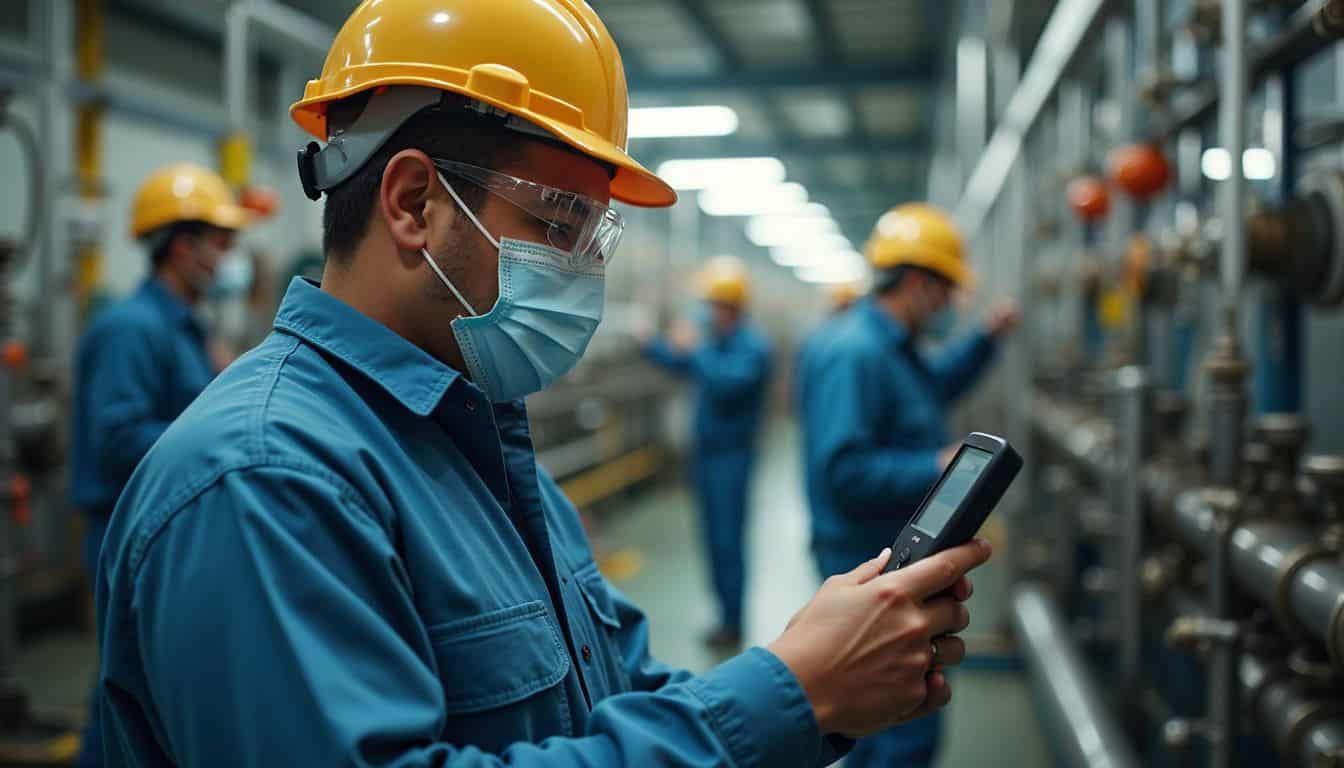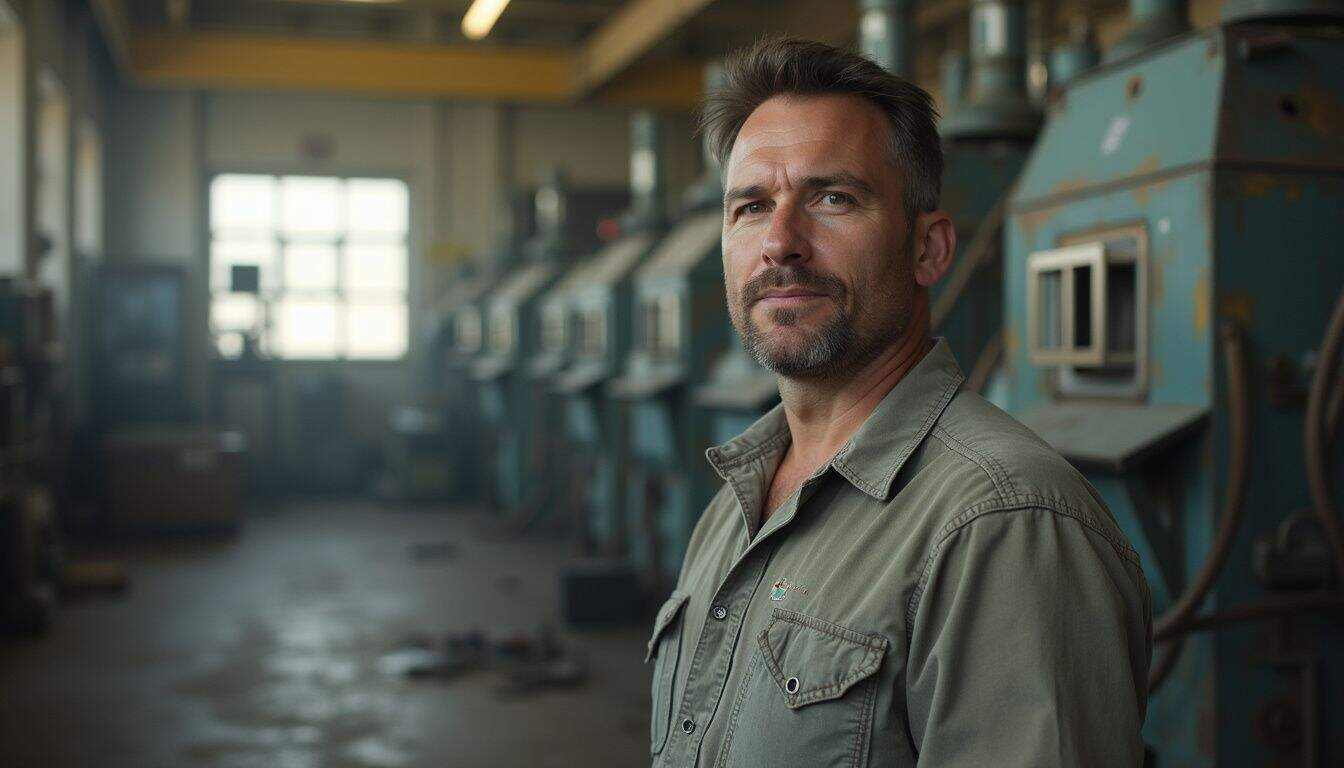Have you ever wondered, “is industrial hygiene a good career?” Maybe you’re looking for a job that truly helps people, but you aren’t sure where your science skills fit in.
Or perhaps you’re weighing if becoming an industrial hygienist is worth it compared to other health and safety careers.
I get it completely. It’s a field that isn’t always well understood, but it’s packed with purpose and opportunity.
Here’s something to consider: the Bureau of Labor Statistics expects about 12,000 job openings for health and safety specialists each year for the next decade. This field offers stable jobs with solid pay and a real sense of mission. In this post, I’ll walk you through seven strong reasons why this could be the perfect fit for you.
Ready to see if this is your path? Let’s explore it together.
Key Takeaways
Industrial hygiene offers steady job growth, with the U.S. Bureau of Labor Statistics projecting a 4% increase in job openings for occupational health and safety specialists through 2033.
The average salary for an industrial hygienist is around $81,000 per year, with senior roles in the federal government or specialized private sectors earning over $122,000; benefits typically include health insurance, retirement plans, and paid time off.
The field is in high demand across sectors like manufacturing, construction, healthcare, and government agencies like OSHA, where many compliance officers are industrial hygienists.
Holding the Certified Industrial Hygienist (CIH) credential significantly boosts career advancement; candidates need a bachelor’s degree in a science-related field and several years of professional experience to qualify for the exam.
Advanced technology, like wearable smart sensors and data analytics platforms like Cority and Intelex, is transforming workplace safety by enabling real-time hazard monitoring and predictive risk assessment.
Table of Contents
What Is Industrial Hygiene?

Think of industrial hygiene as the science and art of protecting people’s health at work. It’s the front line of occupational health and safety. Professionals in this field anticipate and identify workplace hazards before they can cause harm to employees or employers.
From invisible airborne contaminants on construction sites to physical hazards like noise and repetitive motion in factories, industrial hygienists are trained to evaluate and control them all.
Certified Industrial Hygienists use a mix of science and investigation, employing tools for hazard evaluation, environmental monitoring, and risk assessment to pinpoint problems. My first job out of college was at a chemical plant where our team discovered toxic chemicals in the air during routine checks. We immediately implemented a new personal protective equipment (PPE) program.
The result? We quickly saw a measurable drop in sick days and injuries. The Occupational Safety and Health Administration (OSHA) sets the legal standards for safety, while its sister agency, the National Institute for Occupational Safety and Health (NIOSH), conducts the research that informs those standards. Industrial hygienists help companies meet and exceed these vital benchmarks every single day.
Industrial hygiene is all about making sure people can earn a living without risking their health. It’s a field built on prevention.
Every expert I’ve met since starting my career has emphasized this: effective hazard control boosts both employee well-being and a company’s productivity. If you want to learn more about the educational paths, check out a health and safety degree online program to see what it takes to work in public health fields, from environmental agencies to disease control organizations.
Reasons Why Industrial Hygiene Is a Good Career

An industrial hygiene professional gets to protect people from workplace hazards every single day. This career lets you use science and practical problem-solving to spot risks, control dangers, and make work safer for everyone.
Why is there high demand for industrial hygiene professionals?
Workplace hazards are a constant and costly issue. According to a report from the National Safety Council, preventable work-related injuries cost the U.S. economy an estimated $167 billion in 2022 alone. Companies are highly motivated to reduce these costs and, more importantly, keep their workers safe.
https://www.youtube.com/watch?v=WpySfhNago
This creates a steady demand for qualified industrial hygienists. OSHA regulations mandate strict attention to risk assessment and hazard identification, making certified industrial hygienists and environmental health experts essential for compliance.
Many experienced professionals are also nearing retirement, creating even more openings for the next generation. The U.S. Bureau of Labor Statistics projects around 12,000 job openings for occupational health and safety specialists each year over the next decade. This means that women with the right skills can step into well-paid roles focused on improving workplace safety for everyone.
What are the typical salaries and benefits in industrial hygiene?
After seeing how hot the job market is, let’s talk about what you can expect to earn. As a woman building a career in safety or environmental health, knowing the numbers helps you make smart decisions. Here’s a quick look at typical salaries, based on recent 2024 and 2025 data.
| Position / Sector | Average Salary | Top Salaries | Key Benefits |
|---|---|---|---|
| Industrial Hygienist (General) | $81,000 | Up to $124,000 (Senior roles) | Health insurance, retirement plans, paid time off |
| Federal Government Roles (e.g., OSHA, NIOSH) | $103,500 | $130,000+ | Comprehensive benefits, job security, strong pension |
| State Government Roles | $67,700 | $85,000+ | Stable hours, good work-life balance |
| Senior Industrial Hygienist | $93,900 | Over $122,000 | Leadership perks, potential for bonuses |
| Safety Director | $83,400 | Exceeds $98,000 (Experienced) | Strategic responsibility, company-wide impact |
My own experience taught me that strong benefits like health insurance and generous paid time off are standard in this field. As you gain experience, salaries climb, especially if you earn your Certified Industrial Hygienist (CIH) credential. Professional groups like the American Industrial Hygiene Association (AIHA) and the American Society of Safety Professionals (ASSP) offer great resources for career development and salary negotiation.
Which industries offer opportunities for industrial hygienists?
So many different industries rely on industrial hygienists to keep their people safe. This variety means you can find a role that matches your interests, whether it’s in a high-tech lab or out on a construction site.
- Manufacturing companies need experts to manage chemical hazards, noise, and ergonomic risks like carpal tunnel syndrome in sectors from automotive to pharmaceuticals.
- Construction firms hire hygienists for hazard evaluation related to silica dust, confined space risks, and hearing protection programs.
- Hospitals and healthcare facilities depend on them to control biological hazards, manage hazard communication standards for chemicals, and ensure good indoor air quality.
- Government agencies like OSHA and NIOSH employ many Certified Industrial Hygienists (CIHs) for workplace safety inspections and developing new safety research and regulations.
- Consulting firms offer a chance to work on diverse projects across many sectors, providing expert advice on everything from insurance risk assessments to hazardous waste management.
- Emerging tech fields are a growing area of opportunity. Industries like nanotechnology, battery manufacturing for electric vehicles, and biotechnology all present new and unique workplace hazards that require skilled industrial hygienists to solve.
How can industrial hygienists advance into leadership roles?
Once you’ve found your footing, you might start thinking about moving into leadership. Getting there is about more than just technical skill, it’s about building your influence and strategic thinking.
Earning an advanced credential like the Certified Industrial Hygienist (CIH) is one of the most powerful steps you can take. It signals a high level of expertise and is often a prerequisite for senior positions. Many leaders also pursue a master’s degree in public health or occupational health to deepen their knowledge.
Beyond credentials, developing strong “soft skills” is critical. I’ve seen firsthand that the most successful leaders are excellent communicators. They can explain complex risks in a simple way and persuade management to invest in safety. This involves translating safety data into business terms, like showing how a new ventilation system can reduce lost workdays and increase productivity.
Many successful leaders also become proficient in project management, using tools like Asana or Trello to manage complex safety initiatives. By staying current with new regulations and technologies, you can position yourself as a forward-thinking expert ready to lead.
Skills and Qualifications Required

To succeed in industrial hygiene, you need a solid foundation in science and health. Most jobs also look for hands-on experience with hazard control and risk assessment tools like air sampling pumps or noise dosimeters.
What education do you need for a career in industrial hygiene?
A bachelor’s degree in occupational health, public health, chemistry, biology, or another core science is the typical starting point. My own studies in biology were essential for understanding how toxic chemicals and biological hazards affect the body.
Many top employers look for candidates from programs accredited by ABET (Accreditation Board for Engineering and Technology). Universities like the University of Michigan and the University of Minnesota are well-known for their strong occupational hygiene programs.
While a bachelor’s is the entry ticket, many women in the field pursue a master of public health (MPH) or a master of science (MS) to unlock senior roles and higher earning potential. Internships are also incredibly valuable, they gave me the hands-on hazard evaluation skills that made my resume stand out.
Which certifications are essential for industrial hygienists?
Getting certified is a huge step in building a successful career in this field. It proves your expertise and opens doors to more advanced roles and higher pay.
- Certified Industrial Hygienist (CIH): This is the gold standard. It’s offered by the Board for Global EHS Credentialing (BGC) and shows you have mastered the skills to assess and control all types of workplace hazards. The exam is known to be challenging, with pass rates often around 50-60%, which makes earning it a significant achievement.
- Certified Safety Professional (CSP): Managed by the Board of Certified Safety Professionals (BCSP), the CSP is another highly respected credential. It covers a broader range of safety topics, including risk assessment and management. Many professionals hold both the CIH and CSP.
- Associate Safety Professional (ASP): This is often seen as a stepping stone to the CSP. It’s a great way to show your commitment to the profession while you gain the experience needed for the full CSP certification.
To sit for the CIH exam, you need a combination of education and at least four years of professional experience. Preparation is key, and many people use review courses from providers like Bowen EHS to get ready for the exam. These certifications require ongoing education to maintain, ensuring you always stay current on the latest safety practices and regulations.
What key skills are needed to succeed in industrial hygiene?
Once you have the education and certifications, your day-to-day success comes down to a specific set of skills. This work requires you to be part detective, part scientist, and part communicator.
- Strong analytical skills help you connect the dots when investigating workplace hazards, whether it’s tracing the source of a chemical odor or analyzing noise data.
- Problem-solving abilities are what you’ll use to design effective solutions, like recommending new engineering controls or improving a PPE program.
- Clear communication skills are absolutely vital. You need to explain complex health risks to workers in an easy-to-understand way and present business cases for safety improvements to leadership.
- Attention to detail is crucial for everything from calibrating an air sampling pump correctly to interpreting complex OSHA regulations.
- Tech-savviness is increasingly important. You’ll be using detection devices, like photoionization detectors (PIDs) from companies like TSI, and data management software to track exposures and analyze trends.
- Critical thinking helps you evaluate which controls will be most effective. You’ll use the hierarchy of controls to prioritize solutions, from eliminating a hazard completely to relying on personal protective equipment.
These skills also come in handy for keeping your own spaces safe, from applying good ergonomics to your desk setup to following tips for home office cleaning.
Career Paths in Industrial Hygiene

You can follow several different paths in this field, each with a real impact on safety. If you enjoy using science to solve practical problems, industrial hygiene offers a variety of roles that let you do just that.
What does an Environmental Monitor do?
An Environmental Monitor is a hands-on investigator of workplace and community health. They go to sites to check for toxic chemicals, physical hazards like radiation, and biological hazards from industrial operations.
A typical day might involve collecting and testing samples of air, water, or soil to check for contamination. They use specialized equipment to get accurate readings and help a company meet Occupational Safety and Health Administration (OSHA) standards. After their fieldwork, they write detailed reports that explain their findings and recommend ways to control any identified risks, like improving engineering controls or updating personal protective equipment (PPE) requirements.
What are the responsibilities of a Safety Director?
A Safety Director is a strategic leader who builds and oversees an entire organization’s health and safety programs. Their main goal is to create a culture of safety that protects workers, their families, and the surrounding community.
This leader is responsible for developing safety policies that comply with all OSHA rules and tracking the budget for safety initiatives. They often manage a team of safety specialists and industrial hygienists who conduct air quality tests and other assessments. A big part of their job is education, from training staff on hazard identification to running emergency response drills.
Workplace safety doesn’t happen by accident, it’s the result of strong leadership and a clear strategy.
Safety Directors often work to implement internationally recognized safety management systems, such as ISO 45001, to ensure their programs meet the highest standards. Their work turns scientific data into clear, actionable steps that prevent injuries and illnesses.
What is the role of a Senior Industrial Hygienist?
A Senior Industrial Hygienist acts as a team leader and a top-level technical expert. They often manage complex projects, mentor junior staff, and develop strategies to prevent occupational illnesses across an entire company or region.
These professionals typically hold advanced degrees, like a Master of Public Health, and the CIH certification. Their deep knowledge helps companies navigate complex Occupational Safety and Health Administration (OSHA) regulations. A senior hygienist works closely with engineers, safety directors, and medical staff to build and improve worker health programs, such as hearing conservation or respiratory protection programs.
While they still use their technical skills for complex hazard evaluations, their role is often more strategic. They might spend more time analyzing data, developing policies, and presenting findings to executive leadership. Their influence can shape company-wide safety standards and protect the well-being of thousands of employees.
Future of Industrial Hygiene
The future of industrial hygiene looks bright and is rapidly evolving, thanks to new technologies like real-time digital sensors and smarter hazard evaluation tools. Let’s look at where this career is headed.
What growth opportunities exist in industrial hygiene?
The career outlook for industrial hygienists is very positive. The U.S. Bureau of Labor Statistics projects a steady 4% growth for occupational health and safety specialists through 2033, leading to thousands of new job openings each year.
Growth is particularly strong in industrial hygiene consulting, as more companies need expert help with workplace safety and hazard evaluation. During the COVID-19 pandemic, I saw a huge surge in demand for CIHs who could advise on PPE, ventilation, and biological hazards.
There are also exciting new areas opening up. As companies increase their focus on Environmental, Social, and Governance (ESG) reporting, the skills of an industrial hygienist are becoming highly valued for assessing worker well-being and corporate responsibility. With an average salary around $81,000, and the potential to earn much more with certifications like the CIH or CSP, this field rewards you for your expertise.
How is technology advancing the field of industrial hygiene?
Technology is making the job of an industrial hygienist more precise and proactive than ever before. Smart sensors and wearable devices, for instance, can now track workplace hazards in real time. Instead of waiting for lab results, a CIH can get instant data on a worker’s exposure to toxic chemicals or noise levels.
Many employers are now using integrated EHS software platforms from companies like VelocityEHS or KPA to manage all their safety data in one place. These systems use data analytics and even artificial intelligence to help predict where risks are highest, allowing hygienists to focus their efforts more effectively.
As workplaces adopt more automation and robotics by 2025, industrial hygienists will need to be tech-savvy to evaluate the new and complex safety hazards that come with these systems. This evolution pushes professionals in the field to become leaders in using technology to build smarter, safer workplaces.
How Will Industrial Hygiene Change in 2025?
Looking ahead to 2025, the field of industrial hygiene is set to grow in importance as companies face stricter OSHA rules and a greater public focus on occupational health.
You can expect to see more demand for industrial hygienists in consulting roles, which offers great flexibility and a clear path to leadership. New training programs will also emerge to help professionals stay current on evolving workplace hazards like those found in green technology and advanced manufacturing.
Technology will continue to be a major driver of change. We’ll see wider use of wearable sensors that track exposures to noise or dust in real time, and smarter engineering controls that can adjust automatically to changing conditions. My own team recently started using a digital platform for faster risk assessment, and it has been a game-changer for our response time.
Professional development will remain essential as employment grows, with strong support from organizations like AIHA and ASSP to help you navigate this exciting and evolving career.
People Also Ask
What does an industrial hygienist do in the workplace?
An industrial hygienist is like a detective for workplace health, identifying potential hazards like toxic chemicals, physical dangers from equipment, and even biological threats. They use specialized monitoring equipment to measure risks and then recommend engineering controls or the right personal protective equipment (PPE) to keep everyone safe.
Is a diploma enough for a career in occupational hygiene?
While a diploma can get you started, employers strongly prefer candidates with advanced certifications like the Certified Industrial Hygienist (CIH) or Certified Safety Professional (CSP). A 2022-2023 salary survey by the Board of Certified Safety Professionals noted that certified professionals often have significantly higher earning potential, making it a smart investment for your career.
How does industrial hygiene help community safety?
Industrial hygiene protects nearby communities by ensuring workplace hazards don’t escape into the local environment.
Why is knowledge of OSHA important for an industrial hygenist?
A deep understanding of Occupational Safety and Health Administration (OSHA) rules is essential because they provide the legal standards for safety in the workplace. This knowledge guides an industrial hygienist when evaluating hazards and recommending solutions, ensuring every control measure, from ventilation systems to PPE, meets federal requirements.
Are there real job opportunities for certified industrial hygenists in 2025?
Yes, the job outlook is very positive as companies increase their focus on occupational health and hazard evaluation to comply with safety regulations. The U.S. Bureau of Labor Statistics projects that employment for occupational health and safety specialists is expected to grow, ensuring steady demand for skilled professionals.
